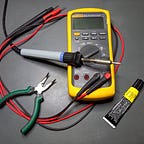How beautiful should a repair be?
Today I repaired a toy from my daughter. A handle from a cheap plastic toy that creates bubbles broke off. I 3d printed a holder that I could glue to the part, that fell off the toy. Unfortunately, I used the black filament, which I had loaded in the printer, to create the part. I was fully aware that the black did not fit the look of the toy, but I thought that it didn’t matter much. The printed part was only visible, when looking from the side, which didn’t really happen during normal use of the toy.
My daughter did not agree with me. She thought that it looked ugly and wanted me to reprint the part in white. As you might have guessed, I printed the part again in another color.
This led me to the title. As I didn’t have an obvious answer, I thought I could think and write about it.
If it’s invisible
One could argue, that when you can’t see it, it doesn’t matter. This is certainly true for the pure visual aspect of beauty. But it has another dimension. If it looks good, it is often a better repair.
Let me give you a small example. Recently I repaired a cheap IKEA balance. A cable has come loose and needed to be resoldered. Before closing it, I laid out the wires in a nice way and taped them to the case. This reduced the stress on the solder joints and made it much easier to close the balance. The beauty will never be seen, but chances are high that it will last for longer and if someone has to repair it again, he or she will have an easier life.
Often it is a good idea to aspire beauty in your repair, even though no one will ever see the result. Beauty has many qualities that are a result of good craftmanship. If it doesn’t look nice, maybe you could do it better. Be careful to not gild the lily though, or you will never finish your repairs.
If it’s something decorative
A completely different situation is at hand when the broken element is visible and part of something decorative. In that situation beauty of the repair is certainly required.
Before doing such a repair, think about it a little harder than usual. As with every repair, there is the possibility to make something worse. If beauty is at stake, you certainly do not want this. One broken piece is already enough, do you want to have to repair two?
If you need glues, solvents or paints on your object, try them out on an invisible part of the object. It can happen that the chemical reacts in an adverse way with the material of the object. In the worst case it looks worse than before.
Make the repair part of the beauty
In Japan, there exists an art-form called Kintsugi. The goal is to visibly repair broken pottery with golden or silver inlays (lacquer). The philosophy behind it is to embrace the broken or the imperfect. To be honest, I do not know anything about kintsugi and have never even held a repaired object in my hand so read up yourself or have a look at some videos.
What we can take from this is to accept that some things will no longer be as they were before. During the repair, we can still try to make it look good, albeit different than the original. Try to think outside of the box, insert different materials in the broken part, cover them with something different or maybe even remove a part entirely.
Functional objects
If the object you are repairing is something purely functional like a power tool. Beauty is obviously secondary. In this situation often safety overrules the visual aspect. If there is a hole in an electrical drill, it needs to be properly closed, regardless of whether it looks good or not.
Ask the owner
The most important answer to the question about beauty cannot be answered in general. whether your repair is acceptable, can only be answered by the owner of the object. Therefore, before you try something that changes the appearance of the object, simply ask the owner. Maybe show him or her, how it could look with sample materials you intend to use for your repair.
I once tried to repair a radio of someone. I couldn’t figure out how to open it and asked whether it was ok to break the case, repair it and then patch it back up. That was one of the rare cases where the person wanted their object back unrepaired.
Conclusion
Beauty is, as usual, in the eye of the beholder. Try to work to your standard of beauty in the repair and try to satisfy the desires of the owner how it should look after the repair.
In my experience beauty is often not very important. People are just happy, that their object works again. What is your experience?
